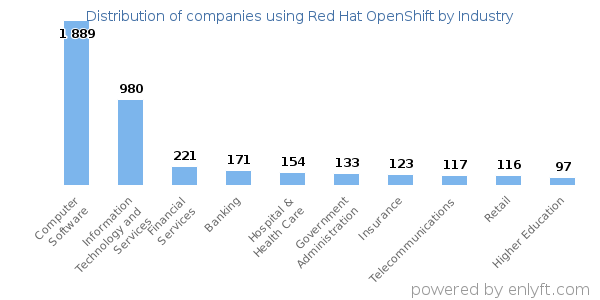What is OpenShift?
OpenShift is a commercialized containerization software product created from an open-source project initiated by the company Red Hat. Also known as Red Hat OpenShift, and previously known as Open Hat Origin, this software is part of a family of containerization software, with the OpenShift Container Platform leading the way as the flagship software.
Deeply explored, OpenShift is a cloud-based platform that operates as a PaaS (platform as a service). OpenShift excels at providing consistent security, centralized policy management, built-in monitoring, and added compatibility features. Developers use it to create, test, and deploy applications featured on the cloud.
OpenShift ships with Red Hat Enterprise Linux, which is Red Hat’s open-source operating system. This OS is the most popular enterprise Linux platform. It is also worth noting that OpenShift supports a host of programming languages such as Ruby, Java, PHP, Go, and Python.
Why Use OpenShift?
OpenShift provides a common platform for enterprise units to host their applications on cloud without worrying about the underlying operating system. This makes it very easy to use, develop, and deploy applications on cloud. One of the key features is, it provides managed hardware and network resources for all kinds of development and testing. With OpenShift, PaaS developer has the freedom to design their required environment with specifications.
Unlike most propriety options, open source platforms like OpenShift have advantageous developer/user communities that can typically assist in quicker bug fixes and increase functionality. OpenShift also combats many of the challenges that containerization can orchestrate, including:
Difficulty deploying containers across various frameworks, languages, or databases
Issues with ramping container resource usage up and down in response to container use
Issues with tracking dependencies
Difficulty tracking and monitoring container deployment on a systemic level to avoid bottlenecks and maximize productivity
Excessive time required to manage overall container usage across your system architecture
Difficulty and time involved in provisioning containers and performing health management checks
Issues with scaling applications
Inability to run both stateful applications and cloud-native stateless applications simultaneously
Excessively complicated container provisioning procedures
OpenShift allows you to address the above issues by using an open-source architecture that enables you to run applications across physical, virtual, public, private, or hybrid cloud infrastructure. Any applications originating on OpenShift can run on any environment supporting Docker-formatted containers.
The platform features a robust set of command-line functionality tools as well as a multidevice web console, facilitating container orchestration across the entirety of your environment. Rapid scalability involving hundreds of instances across thousands of nodes — along with automated application builds and container health management — is also supported.
OpenShift Pros
Better container image management. The ImageStream feature on OpenShift makes it easy to upload and manage a container image without dealing with the registry.
Extensive security features. Because of its strict security policies, OpenShift can identify vulnerabilities and easily redress them.
Excellent user experience. OpenShift offers excellent support to its users in terms of user experience, making it ideal for beginners.
Top Industries that use Red Hat OpenShift
Looking at Red Hat OpenShift customers by industry, we find that Computer Software (29%) and Information Technology and Services (15%) are the largest segments.

The Success story of Lenovo
Lenovo achieves digital transformation with agile cloud services
Overview
Lenovo, a multinational technology manufacturer, wanted to transform digitally to meet business demand and gain a competitive advantage. The company needed agile and cloud capabilities to launch applications more efficiently. Using a Red Hat® Platform-as-a-Service (PaaS) solution, Lenovo decreased system deployment time and improved productivity through greater automation and increased support for collaborative DevOps work.
Challenge: Accelerate change to transform digitally
Lenovo wanted to achieve a rapid digital transformation to improve its capabilities and meet businesses demands faster. However, this transformation required frequent updates and changes to the company’s entire IT environment, and some legacy systems could not keep up. As a result, the team faced major challenges in quickly developing and delivering resources. Lenovo needed a comprehensive solution that could support agile application delivery, increase productivity, and improve internal support for DevOps.
Solution: Move to cloud computing with a PaaS solution
To meet its requirements, Lenovo decided to implement cloud computing with a PaaS solution. “We chose PaaS as the preferred solution to gain efficient and agile support for our business team,” said Zhenyu Yao, executive director, Integrated Technology Service at Lenovo. Building on its strong relationship with Red Hat, Lenovo chose Red Hat OpenShift Container Platform as its PaaS solution.
Results: Increase automation and DevOps collaboration for greater productivity
With its new solution, Lenovo has fully automated its development and production processes, helping developers become more efficient and productive. Its unified PaaS environment lets developers and operations staff collaborate, leading to faster deployment time and increased competitive advantage. IT staff can now build a new IT infrastructure in minutes instead of a week. “With a PaaS built on Red Hat OpenShift Container Platform, along with our automated management tools, we can provide efficient and agile cloud services internally and externally,” said Yao.
CONCLUSION
OpenShift helps to power connectivity and cloud-based delivery worldwide, for leaders in industries across the board. By using OpenShift, these enterprise-level businesses are able to scale their operations, improve their service, and continue to scale and advance their technology platforms.




















